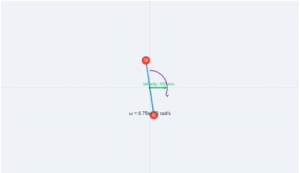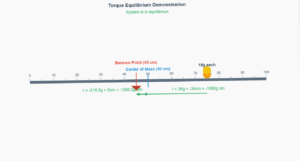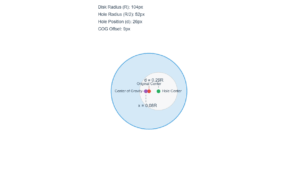Angular Acceleration Simulation
This simulation demonstrates the angular acceleration of a motor wheel as its speed increases from 1200 rpm to 3120 rpm in 16 seconds.
Example
Question:
The angular speed of a motor wheel is increased from 1200 rpm to 3120 rpm in 16 seconds.
(i) What is its angular acceleration, assuming the acceleration to be uniform?
(ii) How many revolutions does the engine make during this time?
Solution:
(i) Angular acceleration:
We use \( \omega = \omega_0 + \alpha t \), where \( \omega_0 \) is initial angular speed (in rad/s).
Convert rpm to rad/s:
\( \omega_0 = 2\pi \times \frac{1200}{60} = 40\pi \) rad/s
\( \omega = 2\pi \times \frac{3120}{60} = 2\pi \times 52 = 104\pi \) rad/s
So,
\[
\alpha = \frac{\omega - \omega_0}{t} = \frac{104\pi - 40\pi}{16} = \frac{64\pi}{16} = 4\pi~\mathrm{rad/s^2}
\]
(ii) Number of revolutions:
Angular displacement after \(t\) seconds:
\[
\theta = \omega_0 t + \frac{1}{2}\alpha t^2
\]
Substitute values:
\[
= (40\pi \times 16) + \frac{1}{2} \times 4\pi \times (16)^2
= 640\pi + 512\pi = 1152\pi~\mathrm{rad}
\]
Number of revolutions:
\[
n = \frac{\theta}{2\pi} = \frac{1152\pi}{2\pi} = 576
\]
Therefore, the angular acceleration is \( 4\pi~\mathrm{rad/s^2} \), and the engine makes 576 revolutions in 16 seconds.
Understanding the Problem
The motor wheel's angular speed increases uniformly from 1200 rpm to 3120 rpm in 16 seconds. We need to calculate:
- The angular acceleration (α)
- The total number of revolutions made during this time
Key Formulas Used
1. Convert rpm to rad/s: ω (rad/s) = (2π × rpm) / 60
2. Angular acceleration: α = (ω - ω₀) / t
3. Angular displacement: θ = ω₀t + ½αt²
4. Revolutions = θ / (2π)



